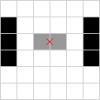Olxinos
French fry. Caution: very salty!
- Joined
- May 7, 2015
- Messages
- 151
- Reaction score
- 88
No, this is identical to adding a single block. You know the CoM of this group (because it's uniform), and you know the mass, so you treat it as a single heavy block.
Well, it might be a good approximation in most cases, but it's not strictly equivalent:

Let's assume you add the two grey blocks to the 6 black blocks. And that we want to compute the moment of inertia about the axis passing through by the red point.
If you consider that a block's mass is concentrated in its center:
- by assuming you're adding a 2-mass "wide block" whose mass is concentrated in its COM:
I_new = I_old + 2*0² (the distance COM-axis is 0 in that case)
- by assuming you're adding two 1-mass block whose mass are concentrated in their respective COM:
I_new = I_old + 1*0.5² + 1*0.5²
If you consider that a block's mass is uniformly distributed in a block volume instead of concentrated in its center, then you have to compute:
 (where rho is the volumic mass)
(where rho is the volumic mass)
and the COM is irrelevant (except to compute the new COM position, which might be what you were talking about).

Let's assume you add the two grey blocks to the 6 black blocks. And that we want to compute the moment of inertia about the axis passing through by the red point.
If you consider that a block's mass is concentrated in its center:
- by assuming you're adding a 2-mass "wide block" whose mass is concentrated in its COM:
I_new = I_old + 2*0² (the distance COM-axis is 0 in that case)
- by assuming you're adding two 1-mass block whose mass are concentrated in their respective COM:
I_new = I_old + 1*0.5² + 1*0.5²
If you consider that a block's mass is uniformly distributed in a block volume instead of concentrated in its center, then you have to compute:
 (where rho is the volumic mass)
(where rho is the volumic mass)and the COM is irrelevant (except to compute the new COM position, which might be what you were talking about).
